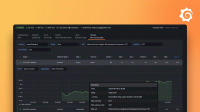Caution
Grafana Alloy is the new name for our distribution of the OTel collector. Grafana Agent has been deprecated and is in Long-Term Support (LTS) through October 31, 2025. Grafana Agent will reach an End-of-Life (EOL) on November 1, 2025. Read more about why we recommend migrating to Grafana Alloy.
Important: This documentation is about an older version. It's relevant only to the release noted, many of the features and functions have been updated or replaced. Please view the current version.
Installing Grafana Agent Operator with Helm
In this guide you’ll learn how to deploy the Grafana Agent Operator into your Kubernetes cluster using the grafana-agent-operator Helm chart.
Note: Agent Operator is currently in beta and its custom resources are subject to change as the project evolves. It currently supports the metrics and logs subsystems of Grafana Agent. Integrations and traces support is coming soon.
By the end of this guide, you’ll have deloyed Agent Operator into your cluster.
Prerequisites
Before you begin, make sure that you have the following available to you:
- A Kubernetes cluster
- The
kubectlcommand-line client installed and configured on your machine - The
helmcommand-line client installed and configured on your machine
Install Agent Operator Helm Chart
In this step you’ll install the grafana-agent-operator Helm chart into your Kubernetes cluster. This will install the latest version of Agent Operator and its Custom Resource Definitions (CRDs). By default the chart will configure the operator to maintain a Service that allows you scrape kubelets using a ServiceMonitor.
Begin by adding and updating the grafana Helm chart repo:
helm repo add grafana https://grafana.github.io/helm-charts
helm repo updateNext, install the chart:
helm install my-release grafana/grafana-agent-operatorReplace my-release with your desired release name.
If you want to modify the default parameters, you can create a values.yaml file and pass it in to helm install:
helm install my-release grafana/grafana-agent-operator -f values.yamlA list of configurable template parameters can be found in the Helm chart repository.
If you want to deploy Agent Operator into a namespace other than default, use the -n flag:
helm install my-release grafana/grafana-agent-operator -f values.yaml -n my-namespaceOnce you’ve successfully deployed the Helm release, confirm that Agent Operator is up and running:
kubectl get pod
kubectl get svcYou should see an Agent Operator Pod in RUNNING state, and a kubelet Service.
Conclusion
With Agent Operator up and running, you can move on to setting up a GrafanaAgent custom resource. This will discover MetricsInstance and LogsInstance custom resources and endow them with Pod attributes (like requests and limits) defined in the GrafanaAgent spec. To learn how to do this, please see Custom Resource Quickstart.



